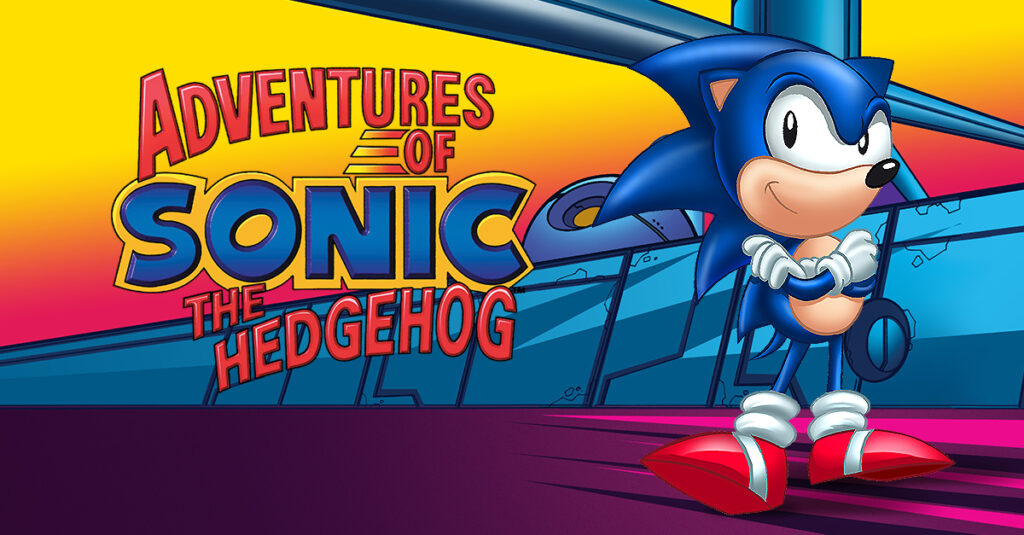You probably don’t need me to tell you that Sonic the Hedgehog has a long, long history of appearing in media outside of video games. If you have been or have had a child at any point since 1993, you know. There’s even a chance you might know a thing or two about the comparatively lesser-known comic books, whether that be the ones produced by Archie Comics or the more recent offerings from IDW Publishing. But if you’re not a hardcore fan of the Blue Blur, you might not know just how varied Sonic media can be.
I’ve been a Sonic fan all my life. For fans like me, a big part of Sonic’s appeal is that stories told with him can have vastly different tones. Sonic can be a silly little guy running around and playing pranks on Dr. Robotnik, or he can be a freedom fighter struggling to free his world from the iron grip of tyranny—mostly by being a silly little guy running around and playing pranks on Dr. Robotnik.
This variety of stories has led to a fanbase with a wide age range, though the stories (at least the official ones) are always appropriate for a young audience. And though the tone of Sonic media can vary from intense but age-appropriate drama to wacky hijinks, there’s always a sense of fun. Just as Batman will always be a symbol of justice, whether he’s a violent vigilante or dancing the Batusi, Sonic will always be one rad dude. So, let’s explore the disparate tones of Sonic the Hedgehog media by taking a quick look at some of the Sonic cartoons and comics we have in our collection. I’ll also be talking a lot about each work’s place in Sonic the Hedgehog history.
For this post, I’ll be talking about 90s Sonic media, and in a later post I’ll talk about the 2000s and beyond. A lot of these titles are just as enjoyable for adults as they are for children, so I’m sure we’ll find something that will interest both you and the kids in your life!
Reader’s Advisory Zone Act 1
Adventures of Sonic the Hedgehog (1993)
This cartoon, produced by Sega of America and DIC Entertainment, thoroughly falls under the “silly little guy” category. Essentially Bugs Bunny for 90s kids, this series features Sonic and Tails constantly outwitting and humiliating a buffoonish Dr. Robotnik and his even more buffoonish henchmen, Scratch and Grounder.
On top of being a well-executed take on the tried and true Bugs Bunny vs. Elmer Fudd formula, Adventures is a really interesting piece of Sonic history. For one, Sonic is voiced by Jaleel White, best known as Steve Urkel in Family Matters. White would voice the character in all three of the 90s Sonic cartoons, and later performers would take on a similar cadence, with only his most recent voice actors deviating from that high-pitched, bratty tone of voice.
Adventures was also the first time the franchise referred to Sonic’s world as Mobius, a name that stuck around until Sega started to take more direct control of the franchise in the 2000s and overruled much of the lore previously established by the cartoons and comics.
Meanwhile, Scratch and Grounder stuck around for a long time, even making cameo appearances in the latter-day Archie Comics Sonic the Hedgehog. Scratch and Grounder also appear in the video game Dr. Robotnik’s Mean Bean Machine, a reskin of Puyo Puyo intended for a North American audience.
And, of course, the theme song has been stuck in my head for 30 years.
I could probably keep going! For a gag-driven cartoon that only aired for one season, Adventures of Sonic the Hedgehog left quite an impact on Sonic’s history. This show is definitely worth a watch if you want to see the history of Sonic unfold, or if you or your family are interested in a lighthearted Sonic cartoon in the style of Looney Tunes.
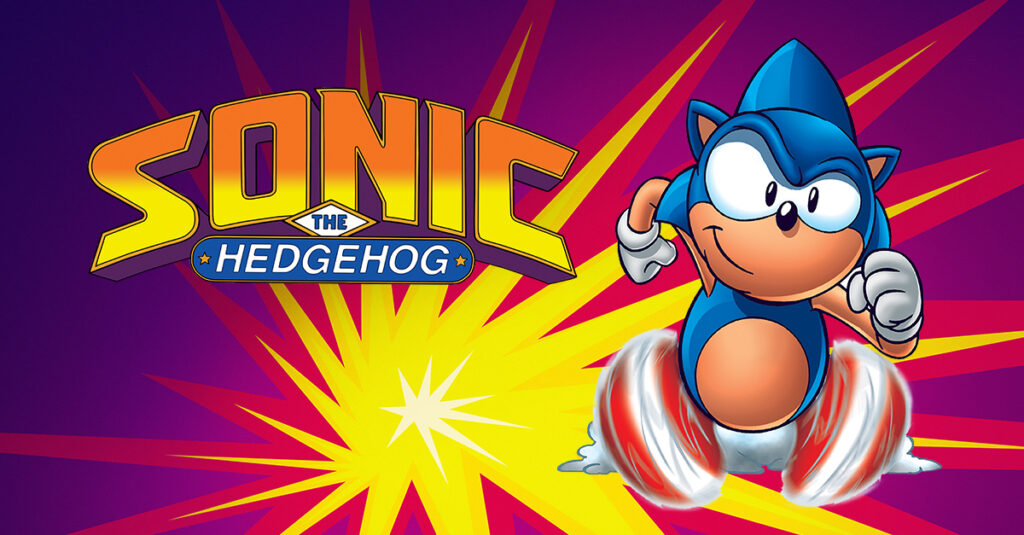
Sonic the Hedgehog (1993-1994)
This show is known among fans as Sonic SatAM due to its airing on Saturday mornings, in contrast with Adventures which aired during the week. For simplicity’s sake, I’ll refer to the show as such for this article. The differences between Sonic SatAM and its weekday counterpart don’t end with their respective time slots either. Whereas Adventures is the quintessential “silly little guy” cartoon, SatAM falls firmly under the “freedom fighter struggling against the iron grip of tyranny” category.
While Sonic himself remains an adventure-loving hedgehog with attitude, the environment we find him in is bleak. Mobius is scarred by the encroachment of technology, and even animals are being transformed into the robotic slaves of the sinister Dr. Robotnik. This version of Robotnik is as terrifying as a cartoon for kiddos can get away with, with Jim Cummings putting in a phenomenal performance (and yes, that is Jim “Voice of Winnie the Pooh” Cummings playing the part of an evil technocratic dictator). Robotnik’s bumbling mechanical sidekicks are replaced with his nephew Snivley, a conniving usurper who plots to overthrow Robotnik.
Though Sonic is the same character, granting levity to a darker world and story, this cartoon gives him a wide cast of supporting characters who keep him grounded. Sally Acorn, Sonic’s love interest and rightful heir to the throne Robotnik has conquered, is the leader of the Freedom Fighters and acts as a level-headed foil to Sonic. Sonic also has an uncle in this cartoon, named Chuck, who serves as a mentor and a constant reminder of what’s at stake. Uncle Chuck was turned into a robot by Robotnik, and it’s Robotnik’s ultimate goal to “roboticize” and enslave the entire planet.
On a lighter note, the theme song is a banger.
Like Adventures of Sonic the Hedgehog, Sonic SatAM left a sizable impression on the franchise. The next piece of media we’ll be discussing is directly influenced by Sonic SatAM, so you’ll see that influence for yourself in the next section. I will note, however, that much like Scratch and Grinder before them, Sally and Sonic’s other friends had some limited video game appearances, in which they cameo in Sonic Spinball.
On the fandom side of things, you can find mods (fan-made modifications to PC games) that put the SatAM characters into virtually every Sonic game ever made, and those same characters still feature heavily in fanart, fanfiction and other fan-created projects to this day. Sally Acorn, in particular, is still a fan-favorite character to this day, with many fan projects devoted specifically to her. So even though Sonic SatAM was only around for about a year, its impact on the Sonic fandom has proved to be immeasurable.
I could talk about this cartoon all day, so I’ll wrap things up. This show provides a great, age-appropriate introduction to drama and science fantasy for young children, making it an excellent series to watch with the kiddos in your life. I highly recommend checking it out.
Sonic the Hedgehog (Archie Comics)
Archie Comics published Sonic the Hedgehog from 1992-2016. These comics largely expand on the characters and story from Sonic SatAM, though elements from other parts of the franchise pop up as well. Sonic the Hedgehog Archives and Sonic Saga Series are two collections of these classic comics. We also have Sonic Select, Sonic Universe, Sonic Boom and Knuckles the Echidna Archives, all of which collect annual issues and spin-offs of Archie Comics’ Sonic the Hedgehog. For the sake of brevity, I’ll only discuss Archives and Saga Series in depth here, but be sure to check out the rest.
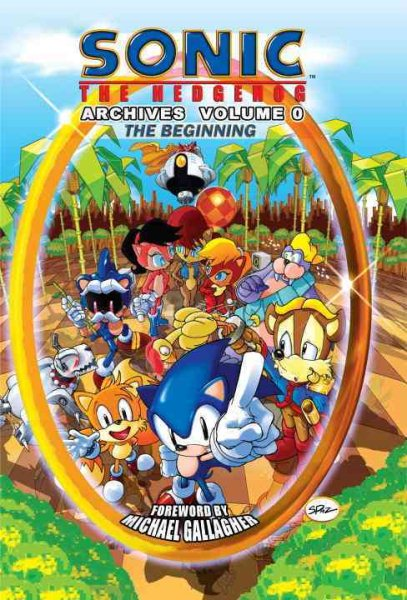
What separates Archives and Saga Series is mostly the writing staff. Archives collects the early comics, which themselves can be separated into two eras.
The early days had a variety of contributors but no singular head writer, although Michael Gallagher was probably the most prominent contributor during this time. This era is notable for a fusion of elements from Adventures of Sonic the Hedgehog and SatAM, featuring the characters from the latter but the humor and tone of the former.
Around the mid-to-late 90s, Ken Penders took on the role of lead writer. Penders’ run is marked by a dramatic shift in tone, somewhat mirroring the grim and gritty tone of 90s superhero comics, though with material still suitable for children. This era is further marked by loving homages to Star Trek, Star Wars and other sci-fi stories and franchises.
Penders introduced a great deal of background and lore to Sonic’s universe, once again mirroring superhero comics. It’s clear from his writing that Penders is fond of stories with deep, complex lore, and he brought that to this franchise in a way that I found accessible even when I was a young child. He also introduced several original characters, and while they might not be as iconic as Sonic and his pals from the video games, they brought a lot of intriguing drama into the story, often challenging Sonic in ways Robotnik couldn’t. These characters could threaten Sonic on a personal level, damaging his reputation and personal relationships.
A lot of Sonic fans have mixed feelings about Penders’ writing, and I confess to being one of those fans. However, I can’t deny that his tenure as lead writer led to some amazing stories with intriguing worldbuilding and compelling interpersonal drama. The four-part Endgame storyline that celebrated the 50th issue was my introduction to the series, and I think it still holds up as a great storyline honoring a great milestone. Penders’ work might not be my favorite run of Archie Comics’ Sonic the Hedgehog, but it’s certainly worthy of standing side-by-side with the rest.
Saga Series
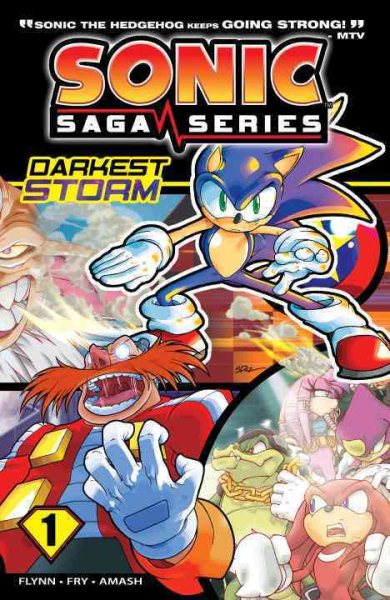 Saga Series, meanwhile, picks up around the mid-to-late 2000s with Ian Flynn as head writer. During this time, Sega took tighter control over what was allowed in spin-off material. Thankfully, Flynn is a Sonic fan to his core, so he was possibly the best choice to make the story flourish within these limitations.
Saga Series, meanwhile, picks up around the mid-to-late 2000s with Ian Flynn as head writer. During this time, Sega took tighter control over what was allowed in spin-off material. Thankfully, Flynn is a Sonic fan to his core, so he was possibly the best choice to make the story flourish within these limitations.
Flynn’s run is marked by fewer wholly original characters and concepts as a result of the short leash Sega had put on the creative team. Instead, we’re treated to deep dives into Sonic lore previously established by Sega and DIC, bringing back one-off characters from Adventures of Sonic the Hedgehog and reimagining them in new and creative ways. Flynn’s tenure as a writer was so well received that Sega recruited him as a writer for Sonic Frontiers.
As previously noted, Archie’s Sonic the Hedgehog expanded on the characters from SatAM throughout its 24-year run. This includes building on Sonic and Sally’s romance from the original cartoon, building a new romance between Antoine Depardieu and Bunnie Rabbot and exploring Uncle Chuck’s past with Sonic’s father. My favorite example, though, is the way the comics build on Nicole.
While Nicole (or, rather, NICOLE with all caps in SatAM) was just Sally’s personal handheld computer in the cartoon, there was always a plan to expand NICOLE’s role and make her a full-fledged character if the series had gotten another season. Archie’s Sonic the Hedgehog runs with this idea, leading to NICOLE, the handheld computer, becoming Nicole the Holo-Lynx, a holographic projection of Nicole’s now sentient AI—and my favorite character in the entire Sonic canon. This is a great example of how the Archie Comics built on what came before, to the point that even a little handheld computer came to life. Or maybe I’m making up excuses to talk about my favorite character. You decide!
Sadly, Saga Series stops just short of the reboot continuity, which is my favorite era of the Archie Comics’ Sonic. For convoluted reasons I won’t get into, the continuity had to be totally rebooted, resulting in the Sonic SatAM cast receiving redesigns and reworked backstories.
This era marked the final days of the Sonic the Hedgehog comics published by Archie Comics. Thankfully, volume 10 of Sonic Select contains the special issues that introduced the revamped backstories for Sally, Rotor, Antoine and Bunnie, but that appears to be the full extent to which the reboot era has been reprinted as of this writing.
That said, IDW Publishing, which we will discuss in detail in a later post, has previously republished tie-in material originally published by other companies, such as Marvel’s Transformers. So there’s still hope that one day we will have the full Archie Comics collection. In the meantime, the issues collected in Sonic the Hedgehog Archives and Sonic Saga Series have a great mix of humor, action and drama. Don’t let my fondness for the reboot era dissuade you from checking out what came before it, because the whole Archie Comics collection is totally worth reading.
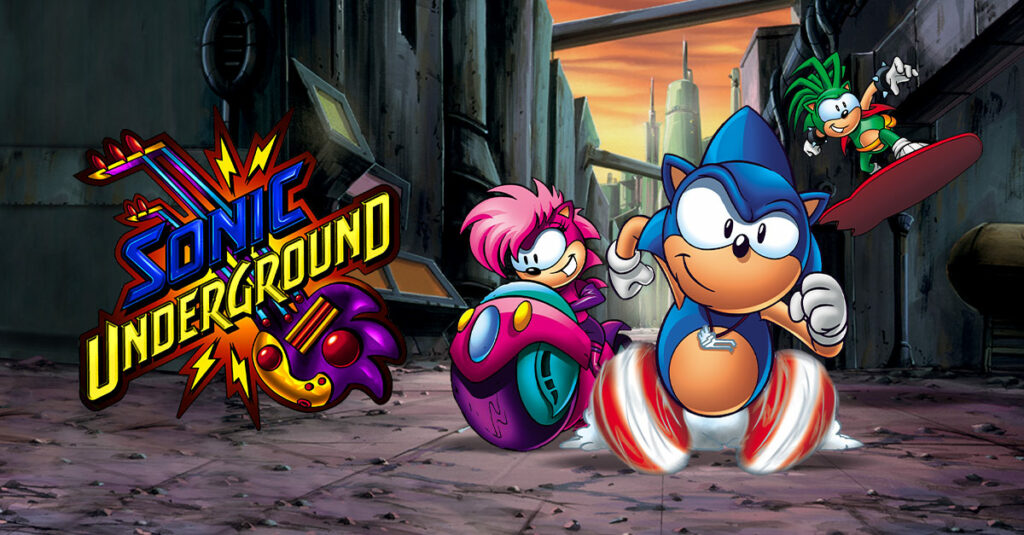
Sonic Underground (1999)
The swan song of 90s Sonic cartoons and of Jaleel White’s performance as the titular character. In this show… Well, to quote the theme song:
Triplets born, the throne awaits
A seer warns of a deathly fate
“Give up your children, separate”
“Bide your time, lie in wait!”
So, yeah, Sonic is royalty in this continuity, and he has a brother named Manic and a sister named Sonia. Much like SatAM, Robotnik has basically already won, and Sonic seeks to overthrow him. Sonic and his siblings are also trying to find their mother, Aleena, while she purposefully stays away for fear of the prophecy.
In terms of tone, Underground has a mix of Adventures’ silliness and SatAM’s seriousness. Sleet and Dingo are by far the most visually intimidating out of all of Robotnik’s henchmen even to this day, and the starting premise of a mother having to give up her children to protect them is heartbreaking. On the other hand, Sonic and his siblings have magical medallions that turn into rock ‘n’ roll instruments and shoot laser beams.
Yeah, this one’s a little weird. Whether that’s a bug or a feature will depend on the viewer. I’m sure kids will love seeing Sonic in a new environment with a new cast of characters, and I think the disparate tones of the show will actually work in favor of that audience. If SatAM is a little too intense for your child, the added levity in Sonic Underground might work better for them.
Critics at the time regarded the plot as overly complex for a children’s show. However, adults are famous for underestimating children, so I’m not so sure I agree. It’s also worth considering that we’re in a post-Steven Universe world, and children’s cartoons with big, over-arching storylines aren’t a rarity anymore. So, in some ways, Sonic Underground was ahead of its time! I think a modern audience will be able to appreciate this series now more than ever before.
Also, this is the only 90s cartoon with Knuckles, which was the biggest selling point for me.
Like SatAM before it, Sonic Underground provides a good, age-appropriate introduction to drama for young children, with the added benefit of providing a little more levity than its predecessor. It’s an odd entry to the Sonic canon, breaking from previous continuities entirely while introducing slightly more magical and mystical elements, as well as a pair of siblings for Sonic. That, however, is what makes Sonic Underground a unique and intriguing part of Sonic’s legacy. It’s a bit of a weird way to end the 90s era of Sonic, but I don’t think I would want it to end any other way.
Readers Got Through Act 1
Next time you see a post from me, we’ll be talking about Sonic media from the new millennium. Check out the rest of our blog in the meantime for more reviews and recommendations!

